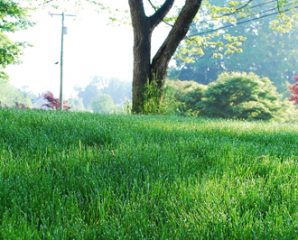We get asked this question every day, and sometimes many times a day. Though it’s not always the easiest to answer, here are some facts that will help you make an informed decision!
There are primarily three cool-season grasses that are used here in the northeast:
Kentucky Blue Grass (Poa pratensis)
Perennial Rye grass (Lolium perenne)
Creeping Red Fescue (Festuca rubra)
Let’s take a closer look at the characteristics of each one of these.
Poa pratensis (Kentucky Blue: KB)
This seed develops above-ground stolons which facilitates spreading and thus, it fills in bare spots. It develops thick underground rhizomes (a root-like structure) that store carbohydrates (energy reserves). These will develop a new secondary plant, spreading and colonizing open areas. The stolons also make KB drought resistant as they store moisture and carbohydrates allowing the plant to go dormant (actually turn brown) and then revive when rain and moisture returns.
It is generally considered the standard for exceptional blue-green color
Most cultivars take at least, if not more, than 21 days just to germinate. It then develops slowly, taking around two months under ideal conditions, before needing the first mowing.
Kentucky Blue Grass takes a whole year before exhibiting full, mature characteristics such as stolons and rhizomes. That’s right, one year!
Cultivars that have the best color tend to green up later in the spring after most turf grass has greened up. KB seeds are about 1/3rd the size of perennial rye or creeping red fescue so when a seed tag says it has 10% Blue Grass (that is 10% by weight) it actually has 30 or 40% by actual seed count, depending on the cultivars used.
FYI: Kentucky Blue Grass has 1,400,000 to 2,200,000 seeds per pound!
Lolium perenne (Perennial Rye Grass: PR) Does not develop stolons or rhizomes like KB. It has limited spreading ability by “tillering” ie. developing a small, young plant from, or at the base of the mature plant. Due to the lack of thick rhizomes, PR is not nearly as drought tolerant as a mature healthy KB plant. It germinates in as little as 3-4 days but typically 7-8 days, continuing to grow rapidly. It may actually need mowing in less than 4 weeks. Cultivars today have color that rivals KB. The untrained eye can commonly mistake PR for KB.
FYI: Perennial Rye Grass has 250,000 to 750,000 seeds per pound
Festuca rubra (Creeping Red Fescue CRF) Does not develop thick stolons and rhizomes like KB. It goes dormant quickly in hot dry conditions especially in full sun. While this is a good survival mechanism, it can give an “early, off-color appearance” in early summer, which indicates dry conditions.
Creeping Red Fescue has a very fine, hair-like texture
This grass is very shade tolerant and is the major component of most shade mixes.
It is often used in seed mixes as it allows light, through its fine texture, reaching the slower germinating, and slow to establish KBG. But once the KBG is mature, it will
out-compete the CRF in full sun.
FYI : Creeping Red Fescue has 250,000 to 600,000 seeds per pound
Next week I will talk more about these grasses in mixes and blends, how they interact, and where and when to use them. Stay tuned!

